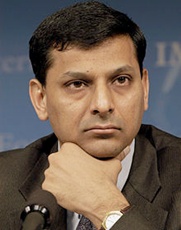RBI hikes repo rate by 25 bps to 7.75 %, cuts overnight lending rate by 25 bps
29 Oct 2013
The Reserve Bank of India (RBI) today announced an increase in its policy repo rate under the liquidity adjustment facility (LAF) by 25 basis points from 7.5 per cent to 7.75 per cent with immediate effect.
 At the same time, RBI reduced the marginal standing facility (MSF), the rate at which the central bank provides overnight loans to scheduled banks, by 25 basis points from 9.0 per cent to 8.75 per cent.
At the same time, RBI reduced the marginal standing facility (MSF), the rate at which the central bank provides overnight loans to scheduled banks, by 25 basis points from 9.0 per cent to 8.75 per cent.
The cash reserve ratio (CRR) of banks will remain unchanged at 4.0 per cent of their net demand and time liability (NDTL), RBI said in a release.
RBI also increased the liquidity provided to banks through term repos of 7-day and 14-day tenor from 0.25 per cent of NDTL of the banking system to 0.5 per cent with immediate effect.
The reverse repo rate under the LAF now stands adjusted to 6.75 per cent.
The Bank Rate stands reduced to 8.75 per cent with immediate effect.
With these changes, the MSF rate and the Bank Rate are recalibrated to 100 basis points above the repo rate.
RBI noted that inflation as measured by the wholesale price index (WPI) rose in September for the fourth month in succession.
This has been part to the pass-through of rupee depreciation into prices of manufactured products, along with elevated food and fuel inflation, which offset possible disinflationary effects of low growth.
While food price pressures may ease with the arrival of the kharif harvest and the usual seasonal moderation, RBI expects overall WPI inflation to remain higher than current levels through most of the remaining part of the year
RBI said the its policy of extending liquidity to banks of up to 0.5 per cent of the bank-wise NDTL has been calibrated by system's requirement and the excess liquidity needed to meet festival demand.
Liquidity up to 0.5 per cent of bank-wise NDTL is available through overnight LAF repos.
RBI said industrial activity in the country has weakened, with a contraction in consumer durables and tepid growth in capital goods, reflecting the ongoing downturn in both consumption and investment demand.
RBI expects a strengthening export growth and revival in some services, along with the expected pick-up in agriculture to support an increase in growth in the second half of 2013-14 relative to the first half, raising real GDP growth from 4.4 per cent in Q1 to a central estimate of 5.0 per cent for the year as a whole.
The revival of large stalled projects and the pipeline cleared by the Cabinet Committee on Investment may buoy investment and overall activity towards the close of the year, it added.
Since the mid-quarter monetary policy review in September, RBI noted, the outlook for global growth has improved modestly, with fiscal concerns abating in the US and lead indicators of activity firming up in the Euro area and the UK.
In emerging and developing economies, the prospect of delay in the tapering of the US Federal Reserve's bond purchases has brought calm to financial markets, and capital flows have resumed.
Nevertheless, headwinds to growth from domestic constraints continue to pose downside risks, and vulnerabilities to sudden shifts in the external environment remain, RBI said.
RBI said the holding off of payments to smaller entities by their bigger counterparts, however, is building up liquidity pressures on small entities, which if left unchecked, could brew a financial crisis.
Remedies partly lie in the speed-up of government and public sector payments, and on measures to channel credit to small and medium enterprises, RBI said.
The flexibility in managing liquidity has helped ease pressures on banks, and the average drawal on the MSF has declined significantly from about Rs1,40,000 crore in mid-September to Rs40 crore by mid-October, and money market rates have fallen by 125 basis points.
Going forward, however, the more durable strategy for mitigating mismatches between the supply of, and demand for, funds is for banks to step up efforts to mobilise deposits, RBI said.
An improvement in export performance over the last two months, coupled with the contraction in non-oil import demand, has enabled a perceptible narrowing of the trade deficit with favourable implications for the current account deficit (CAD) going forward. While the external financing gap has narrowed and the foreign exchange market has somewhat calmed, RBI expects normalcy to be restored in the exchange market only when the demand for dollars from public sector oil marketing companies is fully returned to the market.






















